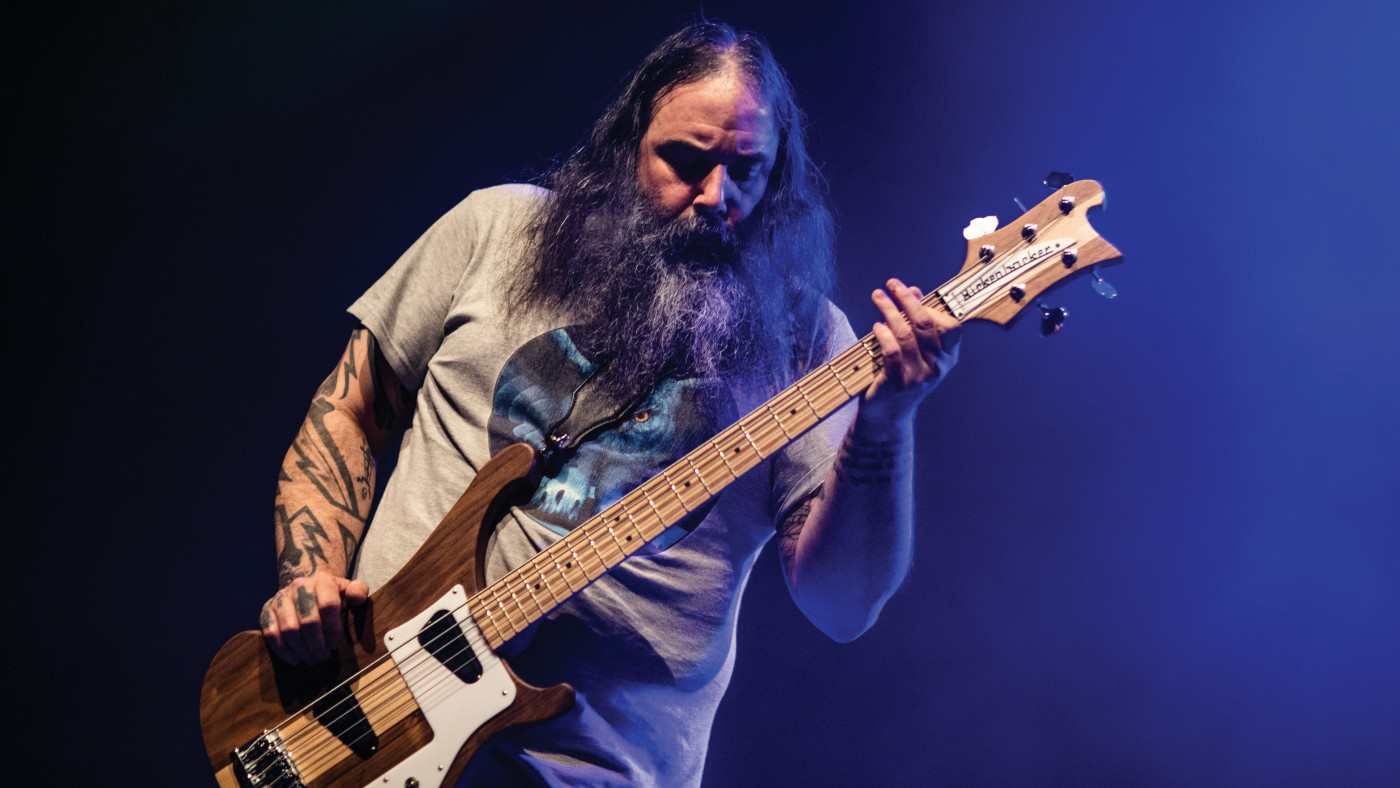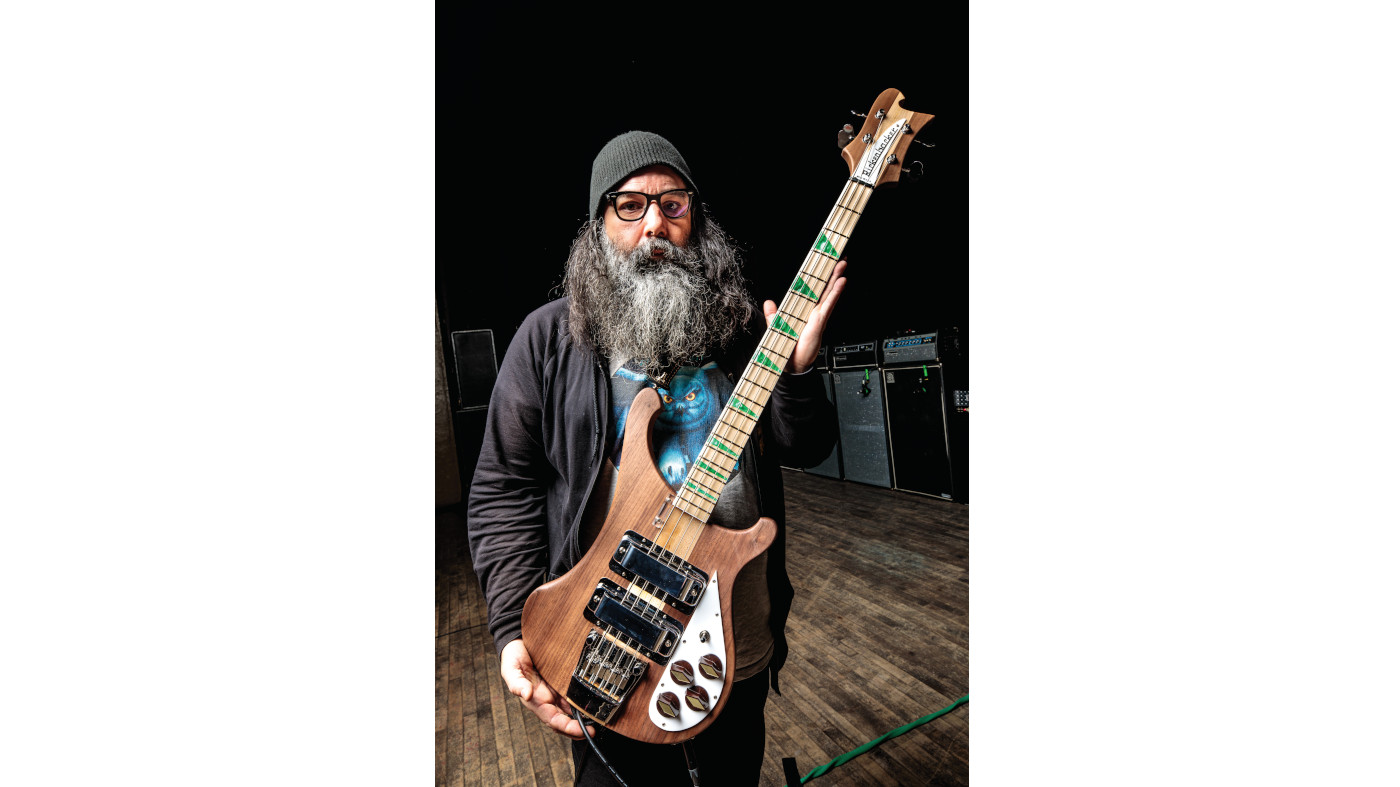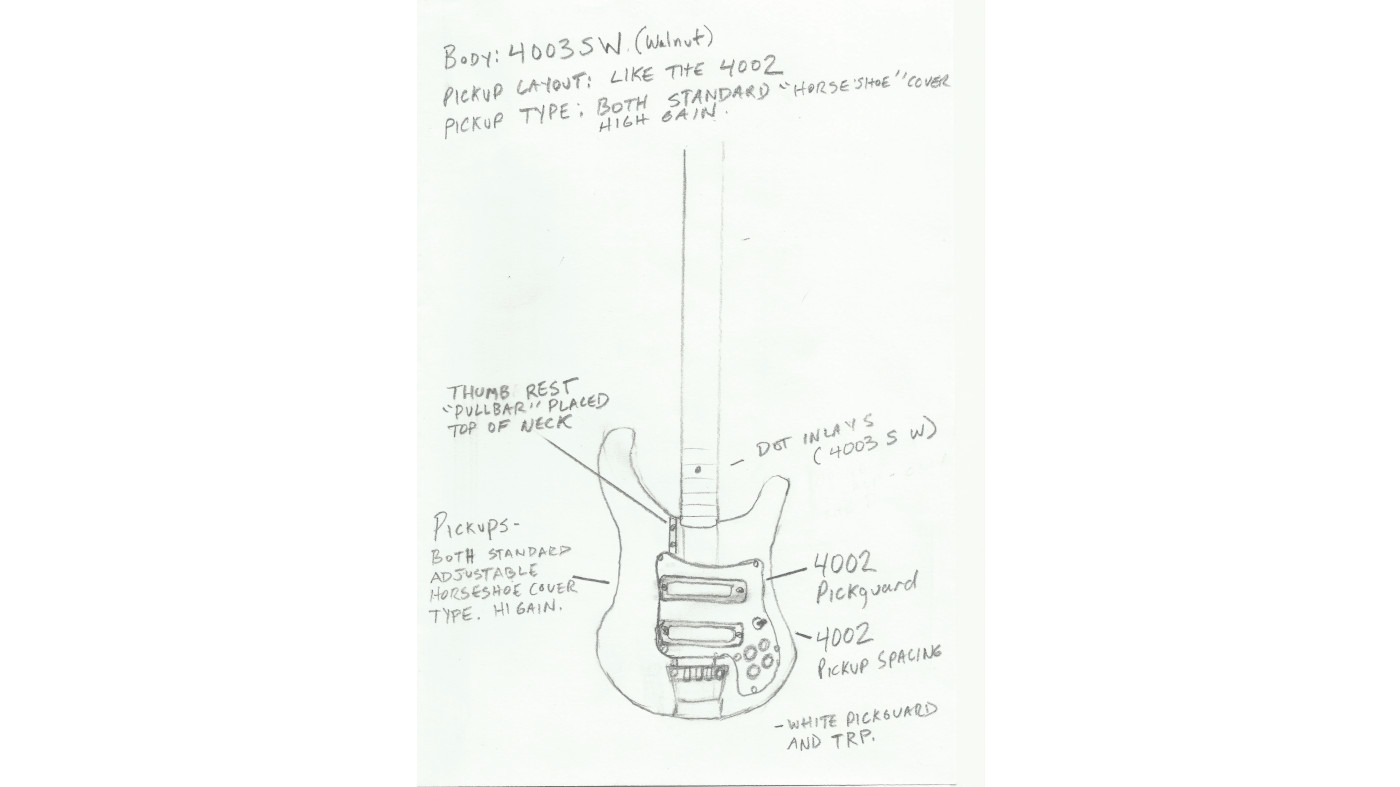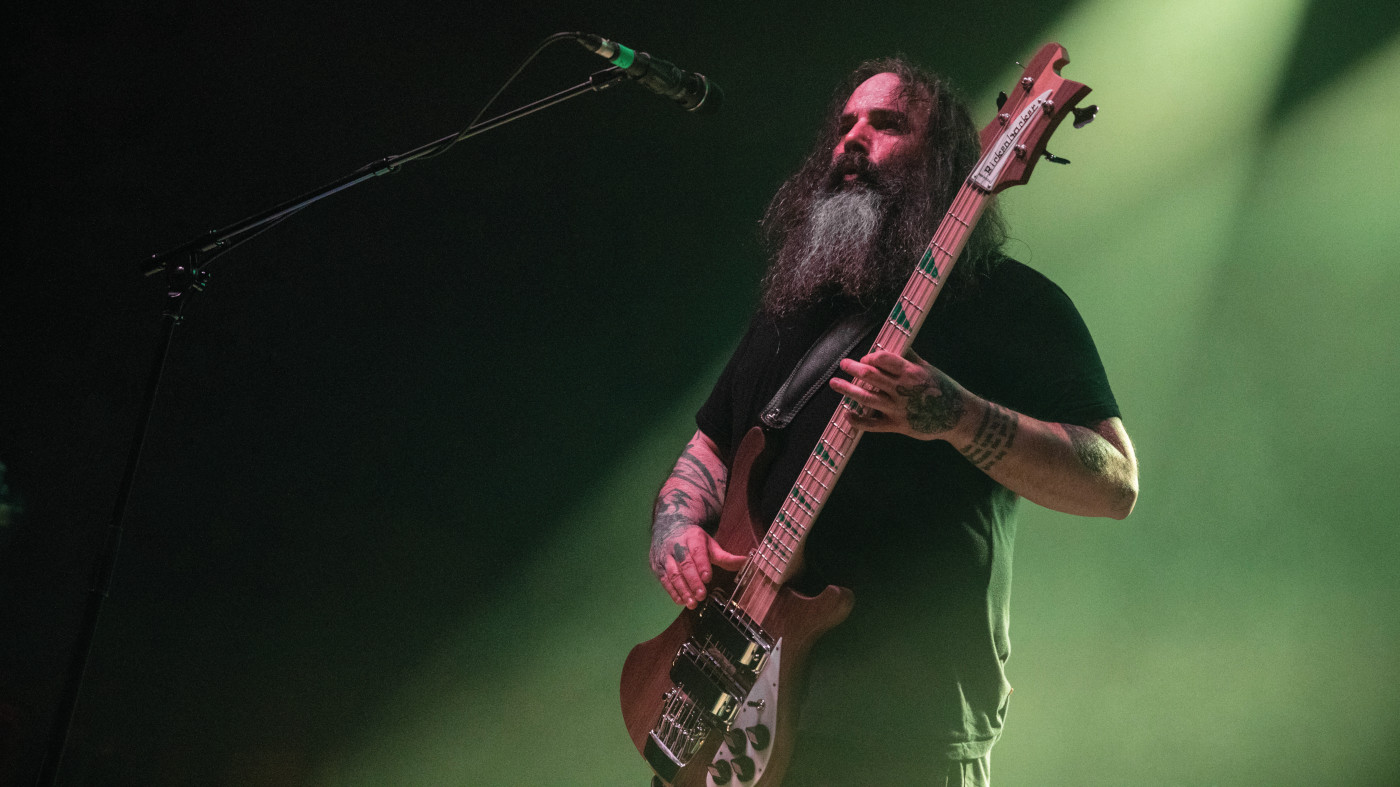Al Cisneros (Sleep/OM): “When I’m stoned it’s readily apparent whether a rhythm has a shelf-life or not”
The Sleep bass man on his new signature Rickenbacker, roots and reggae

If you were a metalhead in the 1990s but you were too fond of slow, stoner grooves to enjoy caffeinated headbangers like Metallica, you might well have been a fan of Sleep, the amazing band from California who released a clutch of all-time classic albums.
The first, Sleep’s Holy Mountain (1992), featured Al Cisneros on bass guitar and vocals and was a truly immense album, loaded with planet-sized riffage and soundscapes that extended far into sub- bass territory.
The second, the monstrous Dopesmoker, appeared seven years later and was a thematic and sonic homage to the band’s preferred backstage pastime. By 2005 Cisneros was also active in a duo (occasionally a trio) called OM, in which the bass supplanted the guitarist’s role with massive, progressive panache.
We meet Al in London the day before an OM gig, where he shows us his fantastic new signature Rickenbacker, the 4003 AC. It’s a delectable bass, tricked out in green (of course) and boasting his signature spec. We pour ourselves a cold one and run the beast through its paces...
Have you always played Rickenbackers?
“I’ve been playing them since 1989. The first punk band I was in, I had a bass that was put together from parts and cost about $40. I used to go into guitar stores, play a Rickenbacker and think ‘Some day I might get one of these. Some day!’ So I made payments once a week, with my paper route earnings, at Starving Musician in Santa Clara, on my first Rickenbacker. It was a beige 4001 with black binding and a black pickguard.”
How many have you had?
Get the MusicRadar Newsletter
Want all the hottest music and gear news, reviews, deals, features and more, direct to your inbox? Sign up here.
“I don’t know, but over the years there have been quite a few. That first 4001 is long gone. The sparkle green one that I got after Holy Mountain but before Dopesmoker was sold, and I tried to buy it back but the guy wouldn’t sell it back to me. There was another one, a 4003 with a pickguard that had been modified; that one is on a lot of tracks on Holy Mountain.
"I remember a 4003 got stolen from the venue in San Jose, where we started. We were there until five in the morning, looking in every part of the venue. We put the word out, but to no avail. But hey, life’s been good, and now I have a signature bass from the factory, so I guess it’s all part of the journey. It helps you to be grateful.”

Rolling with Rick
How did the signature model come about?
“It had been talked about for a couple of years, between Ben Hall and Richard Cannata at Rickenbacker and a friend of mine, Marc Najjar, who is a distributor in Chicago. Even when the idea was in its inception, I was like ‘My God, really? Keep me updated!’ Over the past year there was more and more communication from them, and about six months ago Marc sent me a text saying ‘They’re gonna do it’.
It’s been demanding, but then all music should be demanding or it’s probably bad music
“I sketched out my own schematic after looking at all the models they’d had, from the initial 4000, 4002, 4004, 4005... everything. The final 4003 AC model has all the specifications on it that I suggested, from the two High Gain pickups, the thumb rest access to the top of the neck, and the push-pull on the treble on the right pickup.
"The green inlays were their idea, and I was really happy with that. It was a salute to the first Dopesmoker bass I had custom-painted back in 1993. It’s a full circle in my journey. It’s very humbling - a real honour.”
Will you keep the pickguard covers on, or throw them out?
“I’m leaving them on. Usually I don’t take them off, because I’ve cut my hand on the housings so many times, and I don’t play in that area of the bass very much.”
Who were Sleep’s early influences?
“The early influences were the first four Black Sabbath albums and lots of marijuana, which truly brings focus to the way the riff and the rhythm breathe and move. For me, when I’m stoned it’s readily apparent whether a rhythm has a shelf-life or not. It cuts to the essence of it. The drums and bass are like the heart and lungs of the music, in a way.”
Why do you like Rickys so much?
“My initial interest in Rick came from being a lifelong fan of Geddy Lee. His was the first bass tone I ever heard that stood out separately from the entire song. The bass tone on Rush records completely floored me. I’ll never understand why he went to Steinberger and Wal in the 80s. Maybe him playing a Fender makes sense, but goddamn, you can’t beat the bass tone on Hemispheres. You just can’t have a better bass tone than that. You can hear the veins in the tree which supplied the wood to the bass! So beautiful.”
Who else influenced you?
“Aston Barrett - his timing, phrasing, tone and overall approach to the groove. There’s no bass player more stoner than Familyman. He is the oak tree. Flabba Holt, he has an anchor-like groove. Total sentry. Of course, Butler. And Entwistle as a technical study.”

Exhale
Describe your bass playing for us.
“My bass playing is more incorporated with rhythm these days. There has to be a rest in the measure for the reset of the energy, or the exhalation, while we’re talking about breathing. The balance comes from knowing when not to play, as is the case with drumming too. The main exemplar there is again, Aston Barrett, who is the absolute master of space. When he holds, it’s heavy as fuck. The space makes what he plays that much better.”
The balance comes from knowing when not to play, as is the case with drumming too
How do you write your bass parts?
“There’s usually two rhythms within a time signature - the bassist can define either. You can alternate between the eight versus the four, for example. The bass is like a melodic drum when it’s in the pocket. If we do it right, we put the drums into keys and melodies. The phrasing of the drum styles is inspiring when it comes to creating rhythmic bass-lines. The world lies between the kick and the snare.”
Do you always rest your picking-hand thumb on the neck?
“Yeah, depending on what frets are required on the song I’m playing. I also use the last four or five millimetres of pickguard too, I’m actually very used to doing that. It was so cool to have a thumb rest, finally.”

Why do you prefer that picking style?
“I tried using a pick in the first year I played, and it’s all right, but when the strings are hit towards the top of the neck they generate sound pressure. There’s more of a push through the speaker cone. Look at Geezer Butler, how he used to play up there back in 1970, ‘71. It doesn’t matter where you play it if it doesn’t sound good, but the bass tone that speaks better to my ears is up there. There’s way more rolling, curved elasticity in the sound, as opposed to a digital, square sound.
“And the other thing is that for 25, 30 years I’ve listened exclusively to roots-era reggae. Barrett and Robbie Shakespeare, they play fingerstyle on the top of the neck. Those guys are at the mountain top. Their sound is deeper and has more pressure than any metal band’s bass sound.
“In addition to that, they’re not banging away at the strings: there’s a call and response in the actual physics of the bass string that they’re using as an instrument. So as I experimented more and more with playing bass, it just moved in that direction. I took those examples and worked to make my style a summary of all those things.”
Tubes or solid-state amps?
]“I use tube amps, because there’s a midrange and a general warmth in the tone that may not be that evident live through a PA, but through studio speakers or through tape it’s really obvious. I’ve always preferred that sound, and in OM I experiment with going through the board. In that band, some of the bass requires overdrive and some requires midrange and being more articulate, and with the Rick basses - and this was the idea behind their 4002 - you go straight, and it lets the pickup really speak. I think that’s where you can tell the design, more than anywhere else.
OM was a trailblazer, considering all the guitar-less rock bands around now.
“Thanks. It’s been demanding, but then all music should be demanding or it’s probably bad music, ha ha! But in OM there’s no wall of guitars, so I probably feel how a drummer feels in a normal band. I have two totally different setups in both bands, it drives the techs crazy.”


“I can write anything... Just tell me what you want. You want death metal in C? Okay, here it is. A little country and western? Reggae, blues, whatever”: Yngwie Malmsteen on classical epiphanies, modern art and why he embraces the cliff edge
“You're by far the best guy that we've tried. I would love to have you in the band”: So why did Trent Reznor turn down Richie Kotzen for Nine Inch Nails?









